Cahors
Cahors (French pronunciation: [kaɔʁ]; Occitan: Caors [kaˈuɾs, ˈkɔws, ˈkɔw]) is a commune in the western part of Southern France. It is the smallest prefecture among the 13 departments that constitute the Occitanie Region.[2] Main city of the Lot department and historical center of the Quercy, Cahors is home to 19,878 cadurciennes and cadurciens.
Cahors | |
|---|---|
Prefecture and commune | |
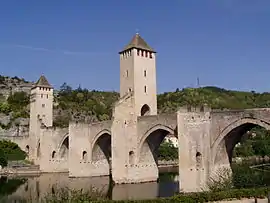 | |
 Flag .svg.png.webp) Coat of arms | |
Location of Cahors 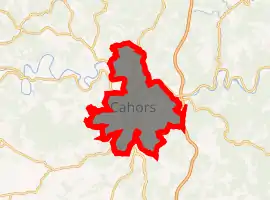
| |
 Cahors  Cahors | |
| Coordinates: 44°26′54″N 1°26′29″E | |
| Country | France |
| Region | Occitanie |
| Department | Lot |
| Arrondissement | Cahors |
| Canton | Cahors-1, 2 and 3 |
| Government | |
| • Mayor (2020–2026) | Jean-Marc Vayssouze-Faure |
| Area 1 | 64.72 km2 (24.99 sq mi) |
| Population (2017-01-01)[1] | 19,878 |
| • Density | 310/km2 (800/sq mi) |
| Time zone | UTC+01:00 (CET) |
| • Summer (DST) | UTC+02:00 (CEST) |
| INSEE/Postal code | 46042 /4675493 |
| 1 French Land Register data, which excludes lakes, ponds, glaciers > 1 km2 (0.386 sq mi or 247 acres) and river estuaries. | |
Nestled in a meander of the Lot and surrounded by steep arid limestone hills, this historic city is home to a great monumental diversity. Mainly inherited from Roman times and the Middle Ages; the city's monumental attributes include a historic city centre, Saint-Étienne cathedral, Roman walls and the famous Valentré bridge (UNESCO World Heritage Site as part of the pilgrimage path to Santiago de Compostela). Famed for its wine and gastronomy (truffles and foie gras) this typical southern French city holds the label of the French Towns of art and History. The cadurcian economy is reliant on Tertiary services and make Cahors the Lot's economic centre.
History
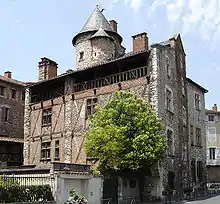
Cahors has had a rich history since Celtic times. The original name of the town was Divona or Divona Cadurcorum, "Divona of the Cadurci," Divona was a fountain, now called "la fontaine des Chartreux", worshiped by the Cadurci, a Celtic people of Gaul before the Roman conquest in the 50s BC. The Cadurci were among the last Celtic tribes to resist the Roman invasion. Cahors derives from Cadurcorum.[3] However, romanization was rapid and profound: Cahors became a large Roman city, with many monuments whose remnants can be seen today. It has declined economically since the Middle Ages, and lost its university in the 18th century. Today it is a popular tourist centre with people coming to enjoy its mediaeval quarter and the 14th-century fortified Valentré bridge. It is the seat of the Diocese of Cahors.
It was also infamous at that time for having bankers that charged interest on their loans. The church in these times said that using money as an end in itself (usury) was a sin. Because of this Cahors became synonymous with this sin, and was mentioned in Dante's Inferno (XI.50) alongside Sodom as wicked.
Pope John XXII, born Jacques Duèze or d'Euse, was born in Cahors in 1249, the son of a shoemaker. In the 2007 Tour de France, Cahors was the start of stage 18.
Geography
The town is situated 115 km (71 mi) north of Toulouse, on the RN20 / A20, connecting the city, via Limoges to Paris and Orléans. The town's height above sea level is between 105 metres (344 feet) and 332 metres (1,089 feet). The area of the town is 64.72 square kilometres (24.99 square miles), with population density relatively high for France at 309 inhabitants per square kilometre.[4]
Main sights
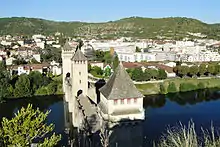
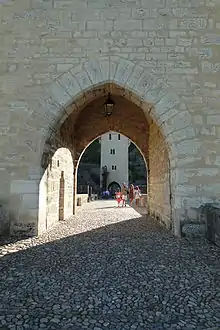
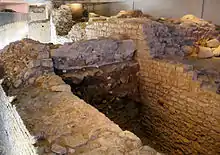
- The Valentré Bridge, the symbol of the town. Building began in 1308 and was completed in 1378. The legend associated with this bridge is one of the most fully realized of all Devil's Bridge legends, with a carefully developed plot, complex characters, and a surprising dénouement. When the bridge was restored in 1879, the architect Paul Gout made reference to this by placing a small sculpture of the devil at the summit of one of the towers.
- Cathédrale Saint-Étienne, a national monument.
- Saint-Barthélémy Church (14th century).
- Maison Henri IV or Hôtel de Roaldès (15th century).
- Daurade quarter with:
- Maison Hérétié (14th–16th centuries)
- Maison Dolive (17th century)
- Maison du Bourreau (13th century)
- The barbican that once defended the Barre Gate.
- Tour des pendus.
- Palais Duèze.
- Tower of Pope John XXII.
- Collège Pélegry.
- Cloister
- Arc de Diane, a relic of ancient Roman baths.
- Roman Amphitheatre – remains of an oval amphitheatre were revealed when the underground car park was excavated at the Place Gambetta, just west of, and partially beneath, Boulevard Gambetta in the city centre. The stone walls can be seen in the car park first level, below the statue of Leon Gambetta, and opened to the public in April 2009.
Wine
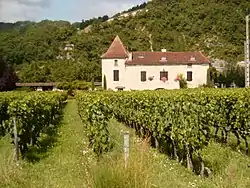
The area around Cahors produces wine, primarily robust and tannic red wine. Wine from the Cahors appellation must be made from at least 70% Malbec (also called Cot, Auxerrois and Pressac) grape, with a maximum of 30% Merlot or Tannat grape varieties.
Culture
The Cahors Blues Festival has taken place annually, in July, since 1982.
Notable people
- Pope John XXII
- Jules Combarieu (1859–1916), musicologist
- Jean Pierre de Caussade [1675-1751), Jesuit priest
- Marcel Marceau (1923–2007), actor and mime artist, d. 2007 in Cahors rest home[5]
- Émile Parisien (1982-Present), jazz musician
- Caro Payro (1992–Present), snowboarder
- Fabien Jouves (1984–Present), famous wine maker
- Tchami (1985-Present), producer and DJ
See also
References
- "Populations légales 2017". INSEE. Retrieved 6 January 2020.
- Commune de Cahors (46042), INSEE
- Bernhard Maier, Dictionary of Celtic Religion and Culture (Boydell and Brewer, 1997, originally published 1994 in German), p. 52.
- Répertoire géographique des communes, publié par l'Institut national de l'information géographique et forestière Archived 8 January 2015 at the Wayback Machine (in French)
- "Marcel Marceau, Renowned Mime, Dies at 84". NYT. The New York Times. 24 September 2007. Retrieved 22 June 2020.
External links
| Wikimedia Commons has media related to Cahors. |
| Wikisource has the text of the 1911 Encyclopædia Britannica article Cahors. |
- Official website (in French)
- Cahors Cathedral at Structurae